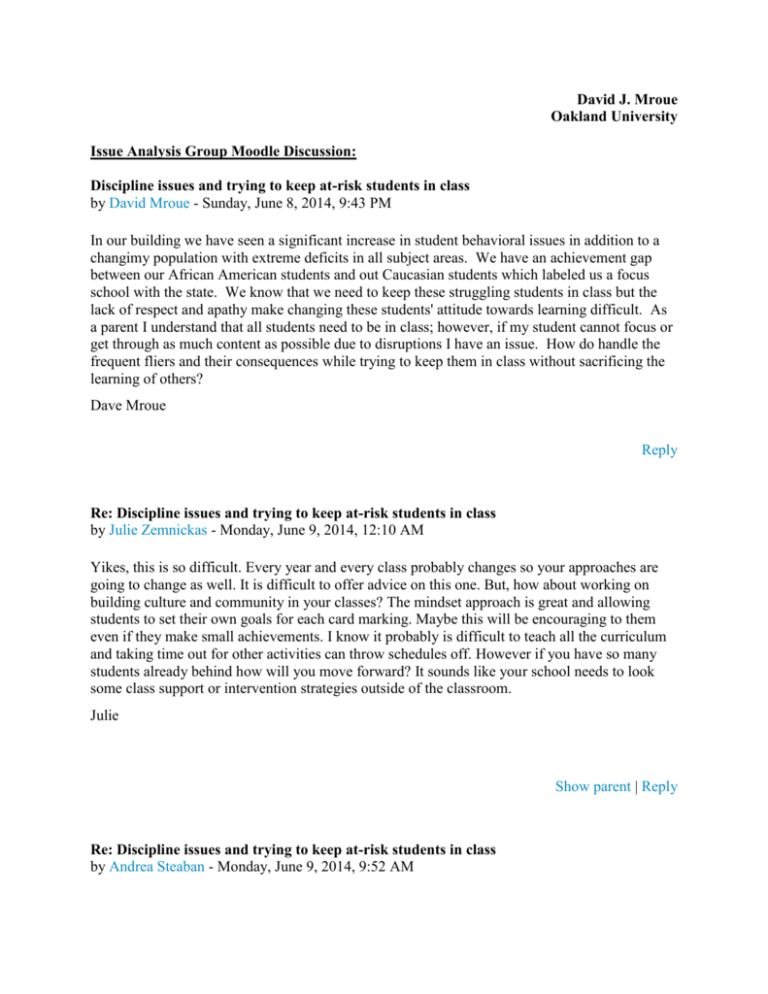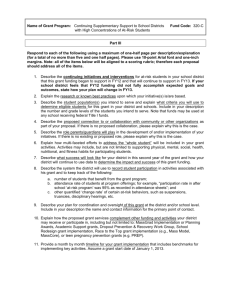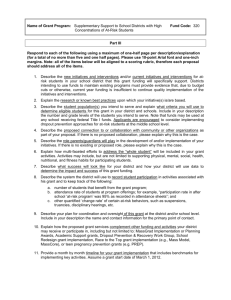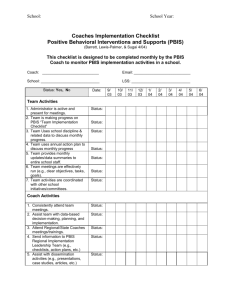Issue Analysis Moodle Post
advertisement

David J. Mroue Oakland University Issue Analysis Group Moodle Discussion: Discipline issues and trying to keep at-risk students in class by David Mroue - Sunday, June 8, 2014, 9:43 PM In our building we have seen a significant increase in student behavioral issues in addition to a changimy population with extreme deficits in all subject areas. We have an achievement gap between our African American students and out Caucasian students which labeled us a focus school with the state. We know that we need to keep these struggling students in class but the lack of respect and apathy make changing these students' attitude towards learning difficult. As a parent I understand that all students need to be in class; however, if my student cannot focus or get through as much content as possible due to disruptions I have an issue. How do handle the frequent fliers and their consequences while trying to keep them in class without sacrificing the learning of others? Dave Mroue Reply Re: Discipline issues and trying to keep at-risk students in class by Julie Zemnickas - Monday, June 9, 2014, 12:10 AM Yikes, this is so difficult. Every year and every class probably changes so your approaches are going to change as well. It is difficult to offer advice on this one. But, how about working on building culture and community in your classes? The mindset approach is great and allowing students to set their own goals for each card marking. Maybe this will be encouraging to them even if they make small achievements. I know it probably is difficult to teach all the curriculum and taking time out for other activities can throw schedules off. However if you have so many students already behind how will you move forward? It sounds like your school needs to look some class support or intervention strategies outside of the classroom. Julie Show parent | Reply Re: Discipline issues and trying to keep at-risk students in class by Andrea Steaban - Monday, June 9, 2014, 9:52 AM DaveI am in the exact same position! I have been beating my head against the wall trying to figure this out because I can't stand that learning time is taken away from others because of these frequent fliers. I don't have any suggestions but am eagerly waiting others' replies as well! Andi Show parent | Reply Re: Discipline issues and trying to keep at-risk students in class by Eric Gauthier - Monday, June 9, 2014, 12:18 PM Hi Dave, We have dealt with this issue and have come up with a few alternatives to putting students out at home. Students who are high risk for drop out, behavior issues, and apathetic are identified and assigned an adult mentor. The mentor's do weekly check-ins during their planning times. The mentors setup behavior and academic initiatives for the students to achieve for. This has had a positive effect also. Our school is in the process of installing the PBIS system for teaching behavior. A lot of our students do not come with the moral conscious that many of us take for granted. The final intervention our school has is In School Suspension (I.S.S.) Many of our students at a time felt like suspension was free time at home to play video games and miss class. The ISS provides an opportunity to complete work, missing work, and be held accountable during the school. Hence no free time at home. ISS has been particularly effective. Students think twice now when I.S.S. is an option. Hope these ideas help. Eric Show parent | Reply Re: Discipline issues and trying to keep at-risk students in class by David Mroue - Thursday, June 12, 2014, 5:35 PM We have had is but cut it due to financial issues when having to cut and trying to implement new things it is tough. Who supervises the is in your building ??? Show parent | Reply Re: Discipline issues and trying to keep at-risk students in class by Benjamin Morin - Sunday, June 15, 2014, 1:34 PM Dave, Our middle school has been highly involved in a comprehensive PBIS (positive Behavior Intervention Support) model for a number of years. Our high school is in the very beginning stages of adopting a PBIS system. One of our first steps was to create common classroom expectations that will appear, be modeled and reinforced in all classrooms. So as a student I now begin to recognize that the expectations in Mrs. Smith's room are exactly the same as they are in Mr. Jones' room. They are called Husky Habits with tag line Lakeview students are.... There are 3 main points: Respect, Responsibility, and Safety. Under each main point are at most 3 descriptors. This is a start to having the building on the same page. The other element we are going to be starting is a peer mentorship program - 1 senior is going to be paired with one 9 grade student that is characterized by the behaviors you are describing in our question. They are required to check in daily and fill out a weekly behavior chart that is focused on the 3 Husky Habits. We are going to start with 40 9th grade students - there will also be a teacher in charge of a small group of mentees/mentors. It gives those students an opportunity each day to receive personal attention from an adult. In the middle school the PBIS mentoring program is between teacher and student - 3 students that check in with 1 teacher daily. The middle school really promotes reward days, and other advantages that promote positive behavior. For us at the high school we are trying to promote more of an intrinsic reward because of them being older. Maybe you are already doing some PBIS, if not check out https://www.pbis.org/school for some good resources This would be a great program to promote to media outlets, community forums, newsletters, etc. We care about academics but we also care about relationships and building positive behaviors and we have comprehensive systems in place to achieve both. Ben Show parent | Reply Re: Discipline issues and trying to keep at-risk students in class by Gary Hamilton - Sunday, June 22, 2014, 4:43 PM Dave, I’m wondering if we spent more time implementing leadership programs like Leader In Me, if we would see less of the types of student issues we are all witnessing. I’ve got to believe it would help. Leader In Me has a solid presence in elementary schools; however, they have just recently developed their first middle school program. I believe that programs like Leader In Me have a lot of value, only if the approach is K-12. Perhaps, we should spend more time developing character and less time over-testing our kids.





